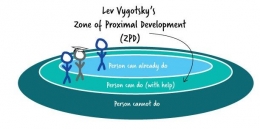Lev Vygotsky was born on November 17, 1896 in Orsha, Russia. He was a Russian Psychologist, known for his concept of the Zone of Proximal Development (ZPD).
Understanding the Theory
The Zone of Proximal Development (ZPD) has been defined as; "the distance between the actual development level as determined by the independent problem solving and the level of potential development as determined through problem-solving under adult guidance, or in collaboration with more capable peers" (Vygotsky, 1978, p.86).
From the statement above, Vygotsky believed that a leaner could not be able to reach the same level of learning on their own. The learner is able to reach their learning goal with the presence of assistance from adult (parents and teachers) or competent peers. He believed strongly that community plays the central role in the process of learning.
Two important components of zone of proximal development (ZPD); the student's potential development and the role of interaction with others. The success of the ZPD learning involves the presence of someone with the knowledge to guide the learner, supportive activities (scaffolding) and social interactions.
ZPD Application in the Classroom
As a teacher, we should know the learner's current level of knowledge because without this information you will not be able to teach them in their ZPD, but how? This can be done through discussion and open-ended questions on the topic. Every child is different, so they may also have different ZPD for each topic. They may do well when working with friends in a group or individually with the support of surrounding teachers.
ZPD is important because it shows the level of children's learning. Teacher should provide new opportunities for learners to go beyond their current skills, provide continuous and scaffolded support for all learners in the classroom. Do not give "too much" help, this causes learners to be passive, instead let the student to work on their own first and if they struggle, the teacher can give some open-ended questions that encourage them to find solutions. This will also help the student to connect their learning to their prior knowledge.
For example, if a child struggling to learn how to read, the teacher can teach the student to sound out the words (phonetic strategies) or implement any other word recognition strategies for the child to be able to learn to read, a painter who struggles to properly mix the colours alone but can do it when the teacher guides the painter toward independence.
By understanding what learners are able to achieve alone and what they are able to achieve with assistance, educators can develop better plans to teach skills in the most effective and possible manners to help the learners to achieve their learning goals.
Learning can lead to development if it occurs within the child's zone of proximal development (ZPD).
Weaknesses of Vygotsky's Theory
Some possible disadvantages are that the process is more tutor-centered and school-centered. The ZPD does not clearly explain the development process and how development actually occurs.
Thank you.









